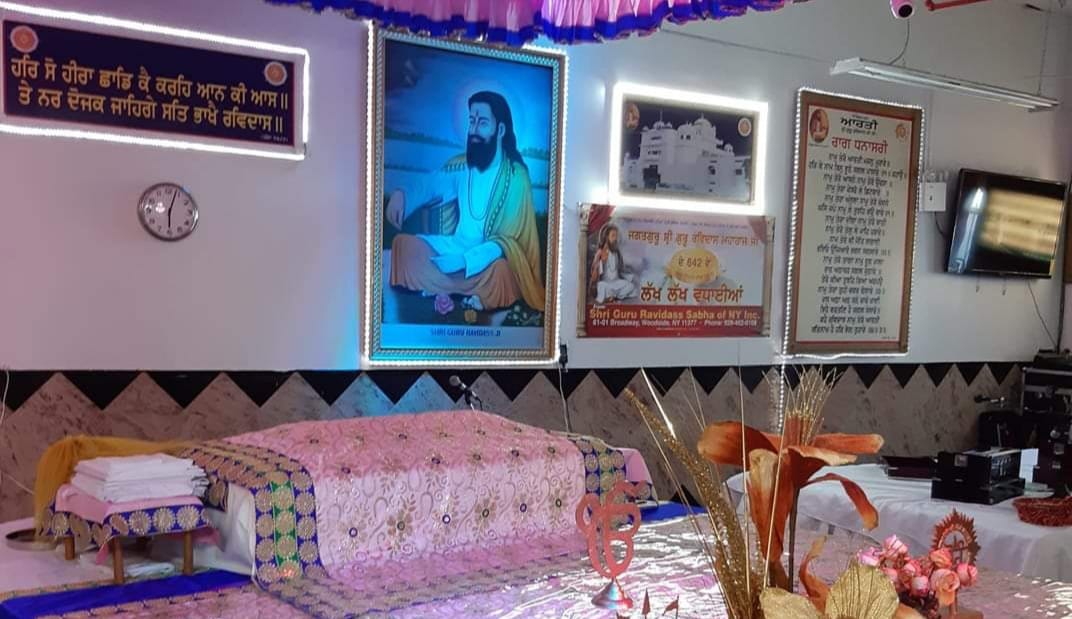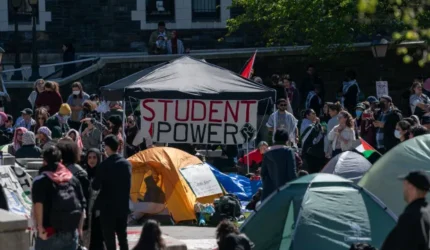
On a sunny Sunday morning in September, a group of CUNY SPS students, including myself, visited the Shri Guru Ravidas Sabha of New York in Woodside, Queens. For some, it was their first time visiting a Sikh temple, and the experience was both surprising and heartfelt. The students came together to witness how the Sikh community embraces newcomers and shares its beliefs.
The visit, held on September 22, was organized by CUNY SPS Student Life Club and Organization Coordinator Parshotam Lal with the School’s South Asian Student Union.
Upon entering, students removed their shoes and covered their heads, a sign of respect and humility. We were welcomed and given the option of eating a small breakfast before the prayer or waiting in a larger room until the service began. The temple’s centerpiece, the Guru Granth Sahib Ji (the holy book), was treated with great reverence, continuously being fanned and covered to show respect. The prayer, sung in the Punjabi language, was accompanied by a string instrument. This created an atmosphere for worshippers of all ages who joined in prayer or walked around the holy book.
Sikhism, which originates from the Punjab region of the Indian subcontinent, emphasizes equality, and this was clearly reflected in our experience at the temple. We were asked to cover our heads as a gesture of respect and humility. The temple also prepares and serves its own food, with everyone sitting together to reinforce the message of equality.
“The food was sooo good, and they kept offering more but I couldn’t eat it [anymore],” Sasikumar explained. “The teachings/beliefs followed by the people who worship here are based on the book which is held in the Golden Temple in Amritsar, India. It was also interesting to see how the temple had its own library with books where one can go to read/study.”
As for myself, a memorable moment was when they honored us as student visitors by presenting us with orange scarves, a color symbolizing wisdom. This gesture felt especially thoughtful, considering we are all students. I left with a deep appreciation for their traditions and the warmth of their community.
“Seeing men and women together in the temple can be a powerful reminder of the values of equality and inclusivity that Guru Ravi Dass advocated,” said Jayantika Nandy, who is pursuing her MS in Research Administration and Compliance. “It highlights the temple as a space where social barriers are often transcended, allowing individuals to come together in shared faith and community. This atmosphere promotes a sense of unity and reinforces the teachings of respect and harmony among all individuals, regardless of gender. Overall, it fosters an environment of collective worship and support, reflecting the core principles of the teachings.”
Reflecting on the day, Nandy noted, “As a Hindu, my religious experiences emphasize community and tradition, so it was fascinating to explore a different faith. The visit provided a deeper understanding of Sikhism’s values of equality and devotion, giving me a meaningful context for engaging with other cultures.”
When the prayers ended, we ate lunch and then went upstairs to the library. The temple is a lot bigger than it appears from the outside. In the library there were several paintings, the largest one was of the activist Dr. B.R. Ambedkar. He was an activist, who believed in education for men and women, as it would bring social progress and fought against discrimination of Sikh people in India.
The visit was fitting to us as students and served as a meaningful reminder that we are on a path of progress. Experiences like these, which incorporate shared practices such as prayer and communal meals, made us feel unity and support. Learning about the foundations of Sikhism added depth, emphasizing values like compassion, community, and resilience. This sense of togetherness from the members of the temple was encouraging and gives us that extra push to keep moving forward, especially in challenging pursuits.
After the tour, the students were given two books: “Annihilation of Caste” by Dr. B.R. Ambedkar and “The Verses of Guru Ravidass,” encouraging further exploration of Sikhism.
The visit opened a window into a different culture and religion for many, highlighting the importance of community, connection, and shared history. The event created a sense of community among participants. Many students, meeting face-to-face for the first time after only interacting online, were able to socialize at the temple visit. Through shared traditions and meaningful conversations, the event created a welcoming space where students of different faiths could connect.
Check out our student events calendar for more ways to connect with SPS clubs and students.




